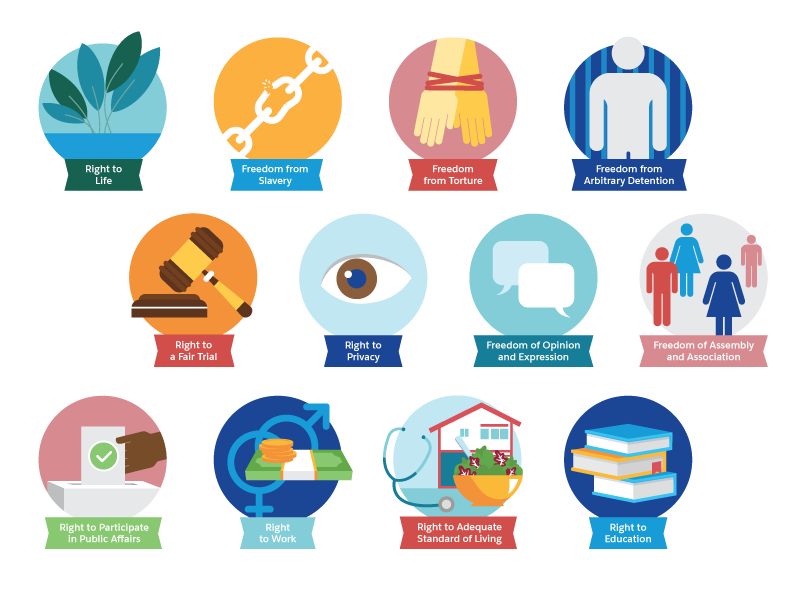Get to Know the Universal Declaration of Human Rights
Learning Objectives
After completing this unit, you'll be able to:
- Explain the importance of the UDHR in world history.
- Indicate what human rights are and list examples of rights contained in the UDHR.
- Find translations of the UDHR.
A Global Commitment Since 1948
On December 10, 1948, the United Nations General Assembly proclaimed the Universal Declaration of Human Rights (UDHR) as a common statement of shared goals and aspirations — a vision of the world as the international community would like it to be — for all peoples and all nations. On that date, the UDHR became the first global document to establish universal human rights, representing a milestone in human rights history.
In this module we’ll explore the significance of the UDHR, including the human rights principles it enshrines; the obligations of Member States to respect, protect, and fulfill the human rights it outlines; its relevance for businesses; how the United Nations (UN) assists in protecting and promoting human rights; and what role we all can play. Salesforce gratefully acknowledges the United Nations Human Rights Office for its valuable contributions and suggestions in the preparation of this module.
Let's begin with a key question: How is the UDHR relevant to each of us today?
Never Again
Spurred by the devastation of World War II, to affirm that such brutality should never occur again, the UN embarked on a journey to develop the human rights provisions of its foundational Charter which had been signed on June 26, 1945. It took three years for the UN Member States — of different cultural backgrounds and from all regions of the world — to create and agree on a shared, universally-inclusive vision of human rights, which became the preamble and the 30 articles of the UDHR. The UDHR was finally proclaimed by the UN General Assembly on December 10, 1948.
From our vantage point today, we experience the continued importance of safeguarding human rights almost daily in the news. Let’s spend some time learning more about the UDHR and its present-day relevance.
Rights for Everyone
In its 30 articles, the UDHR lists the fundamental freedoms and human rights belonging to all human beings, regardless of race, sex, class, country of origin, sexual orientation, or any other differences or background. These include civil and political rights, such as the right to life, liberty, and freedom of expression; and economic, social, and cultural rights, such as the right to adequate healthcare and education.

An Inspirational Source
Since its adoption, the UDHR has served as an inspirational text for many national constitutions. For example, following the end of the apartheid era in South Africa, drafters of a new Constitution and its Bill of Rights drew heavily upon the UDHR.
The UDHR also led the way for a significant number of subsequent international agreements among States to further define and protect the human rights enshrined in the UDHR, which together constitute international human rights law. How significant a number, you might ask? More than 200 international human rights documents!
The UDHR continues to provide the foundational standards for human rights today, with implications that lie far closer to home than international law or your national constitution. The UDHR establishes the basis for each of us, as global citizens, to be a human rights champion by taking a stand against violations of human rights — whether involving discrimination, cruel and inhumane treatment, unequal access to education or healthcare, or other transgressions.
Each year, on December 10, we celebrate Human Rights Day to commemorate the momentous day in which the UN General Assembly adopted the UDHR. To learn more about Human Rights Day, or actions you can take to support human rights — including taking a pledge, right now, to stand up for universal human rights — see the Resources section at the end of this unit.
The Most Translated Document in the World
The UDHR has inspired many peoples in many places, who have translated it in their own languages. As a result, in 1999, The Guinness Book of World Records declared the UDHR the most translated document in the world, with hundreds of translations available, from Abkhaz to Zulu. This is a record that it continues to hold today, with more than 500 translations. For a list of available translations, see the database linked in the Resources section below.
Now that you have a foundational understanding of the UDHR, in the next unit we’ll discover more about the world of human rights, including the principles behind them and States’ obligations to respect, protect, and fulfill them.
Please note: The United Nations retains copyright of the supporting materials included in this education tool.
Resources
- Website: UDHR’s 30 Articles and Preamble
- Website: Stand up for Human Rights
- Website: Human Rights Day
- Database: List of 500+ Translations of UDHR
- High Resolution PDF: Spirou, Defender of Human Rights
- Low Resolution PDF: Spirou, Defender of Human Rights
- PDF: 40 Posters for the UDHR’s 70th Anniversary Campaign
